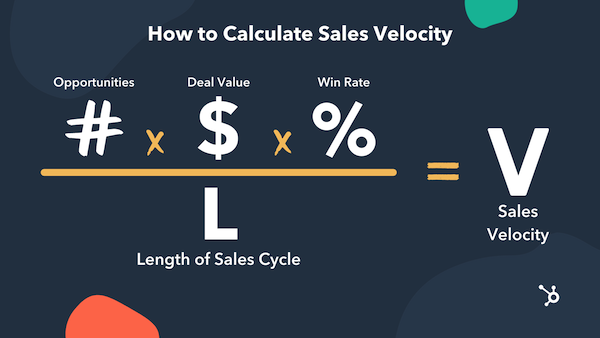Have you been in an interview and asked your prospective employer which sales metrics they value most? That answer is probably, "Yes."

What if I asked you if you'd ever questioned your interviewer about their sales velocity? If you answered "Yes" again, you already know how important this calculation is to understand the growth mindset and overall health of a sales organization.
If you've never thought much about a company's sales velocity, take a moment to brush up on this important equation — and go beyond KPIs to impress your manager or future manager the next time you meet.
So, what is sales velocity?
Sales Velocity
Sales velocity is the measurement of how quickly deals move through your pipeline and generate revenue. A sales velocity equation uses four metrics (number of opportunities, average deal value, win rate, and length of sales cycle) to determine an organization's sales velocity and how much revenue they can expect to generate over a specific period.
The results of the sales velocity equation reflect the health of the business, the overall effectiveness of the sales team, and where the team can increase sales productivity to positively impact revenue goals.
HubSpot Director of Sales Dan Tyresays, "Every sales manager lives in fear their sales pipeline is a bunch of fluff. In today's instant gratification world, uncovering a sense of urgency and establishing sales velocity is important because it uncovers a slow-moving or, even worse, stagnant pipe."
Now that we know what sales velocity is and why it's important, how do we calculate it?
How to Calculate Sales Velocity
To accurately calculate an organization's sales velocity, start by separating small, mid-market, and enterprise pipelines. Your company likely has its own nuanced definition of what constitutes each of these segments and you should divide them accordingly.
Once you've divided your market segments, run a sales velocity equation for each one.
Sales Velocity = Number of Opportunities x Deal Value x Win Rate / Length of Sales Cycle

The Four Factors of Sales Velocity
The four variables that make up sales velocity are all metrics that your CRM should already be tracking, and they comprise of:
- Number of Opportunities
- Average Deal Value
- Win/Conversion Rate
- Length of Sales Cycle
Let's break down what each of these are and how to use them to pilot your organization's planning and goal setting.
- Number of Opportunities - Your pipeline always contains a certain number of opportunities. Make sure they're qualified opportunities. If your pipeline is packed with bad leads and only a few that actually have a chance of closing, your bottom line will suffer.
- Win/Conversion Rate - Your average win rate is tied to your attainment of quality leads. To identify your win rate, divide the number of sales won by the total number of sales opportunities.
- Deal Value (average deal size) - Every deal requires both parties' most valuable resource: time. Make sure you're maximizing this resource for your prospect and yourself by introducing offers or add-ons to make your prospect's life better while increasing your average deal value and increasing your sales velocity.
- Length of Sales Cycle (measured in months) - This is the only sales velocity factor you don't want to increase. Creating a more efficient sales process, redefining your sales playbook, and sometimes adding headcount to your sales team are all ways to shorten your average sales cycle and close more quality deals faster.
Creating Sales Velocity: Best Practices
1. Work toward increased sales effectiveness.
First, if the results of your sales velocity equation point to a need for increased sales effectiveness, work to increase your number of opportunities, average deal value, and/or win rate.
Generally speaking, you can suffer from the numbers above the line (the numerator of the formula) and still run a successful sales organization. When you have a problem with the length of your sales cycle (the denominator), however, your business may suffer.
Dan Tyre explains, "I worked with a portfolio company that had a big, fat pipeline going into the last quarter of the year. But we quickly saw that we were in trouble when none of the deals were progressing to the evaluation stage."
He continues, "Not taking careful account of how quickly something went from opportunity to opportunity to demo to price negotiation to contract really hurt us." Having a calculated sales velocity helps companies like this one plan for a longer sales cycle and analyze how to shorten it moving forward.
2. Lengthen the period you analyze sales velocity.
Second, the longer the length of time you analyze, the better. Measure the sales velocity of at least a quarter and as much as six months to one year. This extended sample period accounts for variables such as seasonality or an unusually long deal.
3. Keep your variables and definitions consistent.
Third, keep your variables and definitions consistent while calculating sales velocity. For example, when do you consider a lead to be a quality opportunity? Does it start when a lead fills out a specific form? Is it when they read a specific blog post on your site? Or is it not until they've scheduled their first phone call? Define these criteria early and keep them consistent when measuring sales velocity.
How to Increase Sales Velocity
Once you have the metrics to calculate sales velocity, you can then work on improving it. Thinking about the four factors above that you use to determine velocity, it stands to reason that improving velocity means improving those four metrics.
1. Increasing Sales Velocity by Increasing Your Number of Opportunities
To boost sales velocity, consider sourcing high-quality leads — even if that means attracting fewer total leads. Tyre says, "It's better to see opportunities show up and then terminate, rather than see the same tired pipeline week after week." For salespeople, bad leads are a fact of life, but moving on from them quickly benefits your sales velocity and your revenue.
You can source high-quality leads using many different strategies such as:
2. Increasing Sales Velocity by Improving Your Win/Conversion Rate
Improve your win rate by capturing and nurturing high-quality opportunities like referrals or prospects who've already demonstrated high intent to buy. To do so, you should:
- Remove prospects who have unavoidable roadblocks from the pipeline.
- Define clear next steps for high-quality prospects.
- Involve the decision-maker at the earliest convenience.
3. Increasing Sales Velocity by Increasing Average Deal Value
Never force a product or service on a buyer who doesn't need it — that's a recipe for losing prospects and churning new customers. Instead, uncover hidden pain points of theirs and offer more than what they expect like:
- Product or service add-ons for more ease of use
- After-sales services such as guides and product training
4. Increasing Sales Velocity by Shortening the Length of the Sales Cycle
The more efficient your team operates, the quicker sales can be closed. Shortening your sales cycle can be done in a multitude of ways, such as:
- Automating repetitive tasks.
- Setting agreed-upon goals for each sales call.
- Exploring prospect objections before responding to them.
- Being clear about pricing (very) early on.
- Making it ridiculously easy for prospects to sign contracts from any device.
- Focusing on your highest-performing channels.
Now that we’ve gone through some methods of increasing sales velocity, let’s discuss how discounts can affect it, too.
How Discounts Affect Sales Velocity
Discounts aren't always the answer to increasing revenue, but by offering your prospects incentives to close earlier, you can potentially decrease the length of your sales cycle — and positively affect your sales velocity.
Make sure your reps are well trained on how to use discounts to benefit deals instead of stunting your company's growth and serving as a crutch to struggling sales teams.
Track and Improve Your Sales Velocity
A healthy pipeline or bigger sales team isn't enough to keep an organization growing — in fact, it can have the opposite effect. Measure your sales velocity, know what the results mean, and have actionable steps in place to improve upon it quickly.
Editor’s note: This article was originally published in May 2019 and has been updated for comprehensiveness.
Sales Metrics
![Sales Analytics: A Simple Guide [+ The Best Software]](https://2406023.fs1.hubspotusercontent-na1.net/hubfs/2406023/Image%20of%20a%20succesful%20casual%20business%20woman%20using%20laptop%20during%20meeting.jpeg)
![The Top Performance Metrics Sales Pros are Tracking in 2022 [New Data]](https://2406023.fs1.hubspotusercontent-na1.net/hubfs/2406023/Imported_Blog_Media/sales-performance-metrics.jpg)
.jpg)